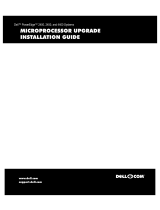
sets in the following bank(s): Bank
DIMMnX
specified bank(s) are not the
same type and size; faulty
memory module(s).
and that they are properly installed. If the problem persists, replace the
faulty memory module(s) (see "Memory Modules").
Amount of available memory limited to
256 MB!
OS Install Mode is enabled in
the System Setup program.
Disable OS Install Mode in the System Setup program (see "Using the
System Setup Program").
Loose or improperly connected
mouse or keyboard cable; faulty
mouse or keyboard.
Check the mouse and keyboard cables and connectors. If the problem
persists, replace the mouse and keyboard. If the problem persists, replace
the system board (see "System Board").
BIOS Update Attempt Failed!
Remote BIOS update attempt
failed.
RetrytheBIOSupdate.DownloadthelatestfirmwarefromtheDellSupport
website at support.dell.com.
Improperly connected or missing
CD/diskette drive.
Ensure that the CD/diskette drive is properly installed. If the problem
persists, replace the CD/diskette drive (see "CD/Diskette Drive").
CPUs with different cache sizes detected
Microprocessors with different
cache sizes are installed.
Ensure that all microprocessors have the same cache size and that they
are properly installed (see "Memory Modules").
Decreasing available memory
Faulty or improperly installed
memory modules.
Ensure that the memory modules are properly installed. If the problem
persists, replace the faulty memory module(s) (see "Memory Modules").
Diskette drive n seek failure
Incorrect configuration settings in
the System Setup program.
Faulty or improperly installed
diskette drive.
Run the System Setup program to correct the settings (see "Using the
System Setup Program").
Ensure that the diskette drive is properly installed. If the problem persists,
replace the diskette drive (see "SCSI Configuration Information").
Faulty or improperly inserted
diskette.
Diskette subsystem reset failed
Faulty or improperly installed
diskette drive.
Ensure that the diskette drive is properly installed. If the problem persists,
replace the diskette drive (see "SCSI Configuration Information").
Faulty or improperly installed
memory modules.
Ensure that the memory modules are properly installed. If the problem
persists, replace the faulty memory module(s) (see "Memory Modules").
Embedded server management error
Embedded server management is not
present.
Embedded server management
memory may be temporarily
corrupted
To clear the embedded remote access memory, shut down the system,
disconnect the power cords, wait approximately 30 seconds, reconnect the
power cords, and restart the system. If the problem persists, replace the
ERA/O card (see "ERA/O Card").
Error: Maximum PCI option ROM count
exceeded!
Too many expansion cards have
ROM enabled in the System
Setup program.
Disable ROM for some of the expansion cards (see "Using the System
Setup Program").
Faulty keyboard controller; faulty
system board.
Replace the system board (see "System Board").
Hard disk controller failure
Hard disk read failure
Incorrect configuration settings in
System Setup program;
improperly installed hard drive, or
loose interface or power cable;
faulty hard-drive controller
subsystem.
Run the System Setup program to correct the drive type (see "Using the
System Setup Program"). If the problem persists, ensure that the hard
drives are properly installed (see "Hard Drives"). If the problem persists,
replace the system board (see "System Board").
I/O parity interrupt at address
Faulty or improperly installed
expansion card.
Ensure that the expansion cards are properly installed. If the problem
persists, replace the faulty expansion card(s) (see "Expansion Cards").
Invalid configuration information -
please run SETUP program
Incorrect configuration settings in
System Setup program;
NVRAM_CLR jumper is installed;
faulty system battery.
Check the System Setup configuration settings (see "Using the System
Setup Program"). Remove the NVRAM_CLR jumper (see Figure5-2 for
jumper location). If the problem persists, replace the system battery (see
"System Battery").
Invalid memory configuration detected;
potential for data corruption exists
Faulty or improperly installed
memory modules.
Memory modules must be populated in the following order: DIMM_1A and
DIMM_1B must be in the first slots populated; DIMM_2A and DIMM_2B must
be in the second slots populated, and so on.
Remove and reseat the DIMMs in their sockets. If the problem persists,
replace the memory module ("Memory Modules").
Invalid NVRAM configuration, resource
re-allocated
System configuration data has
been ignored.
Check the System Setup configuration settings (see "Using the System
Setup Program").
Invalid SCSI configuration; SCSI cable
not detected on connector SCSIB of the
primary SCSI backplane, daughter card
present
Invalid SCSI configuration; SCSI cable
detected on connector SCSIB of the
primary SCSI backplane, daughter card
not present
A SCSI cable is not connected to
the channel B connector on the
SCSI backplane board; SCSI
backplane daughter card is
installed.
A SCSI cable is connected to the
channel B connector on the SCSI
backplane board; SCSI backplane
daughter card is not installed.
If a cable is connected to the SCSIB backplane board connector, the SCSI
backplane daughter card must be installed. Install the SCSI cable to SCSIB
backplane board connector (see "Installing the SCSI Backplane Daughter
Card").
If a cable is connected to the SCSIB backplane board connector, the SCSI
backplane daughter card must be installed. Install the backplane daughter
card (see "Installing the SCSI Backplane Daughter Card").
Keyboard controller failure
Faulty keyboard controller; faulty
system board.
Replace the system board (see "System Board").
Keyboard clock line failure
Keyboard data line failure
Keyboard failure
Keyboard stuck key failure
Loose or improperly connected
keyboard cable; faulty keyboard;
faulty keyboard controller.
Check the keyboard cable and connector. If the problem persists, replace
the keyboard. If the problem still persists, replace the system board (see
"System Board").
Memory address line failure at address,
read value expecting value
Faulty or improperly installed
memory modules.
Ensure that the memory modules are properly installed. If the problem
persists, replace the faulty memory module(s) (see "Memory Modules").




















